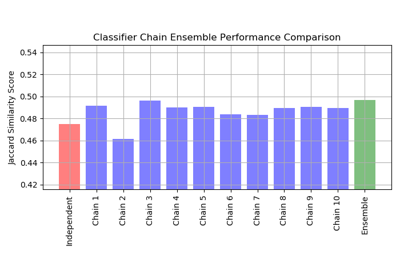sklearn.metrics.jaccard_similarity_score¶
-
sklearn.metrics.jaccard_similarity_score(y_true, y_pred, normalize=True, sample_weight=None)[source]¶ Jaccard similarity coefficient score
The Jaccard index [1], or Jaccard similarity coefficient, defined as the size of the intersection divided by the size of the union of two label sets, is used to compare set of predicted labels for a sample to the corresponding set of labels in
y_true.Read more in the User Guide.
Parameters: - y_true : 1d array-like, or label indicator array / sparse matrix
Ground truth (correct) labels.
- y_pred : 1d array-like, or label indicator array / sparse matrix
Predicted labels, as returned by a classifier.
- normalize : bool, optional (default=True)
If
False, return the sum of the Jaccard similarity coefficient over the sample set. Otherwise, return the average of Jaccard similarity coefficient.- sample_weight : array-like of shape = [n_samples], optional
Sample weights.
Returns: - score : float
If
normalize == True, return the average Jaccard similarity coefficient, else it returns the sum of the Jaccard similarity coefficient over the sample set.The best performance is 1 with
normalize == Trueand the number of samples withnormalize == False.
See also
Notes
In binary and multiclass classification, this function is equivalent to the
accuracy_score. It differs in the multilabel classification problem.References
[1] Wikipedia entry for the Jaccard index Examples
>>> import numpy as np >>> from sklearn.metrics import jaccard_similarity_score >>> y_pred = [0, 2, 1, 3] >>> y_true = [0, 1, 2, 3] >>> jaccard_similarity_score(y_true, y_pred) 0.5 >>> jaccard_similarity_score(y_true, y_pred, normalize=False) 2
In the multilabel case with binary label indicators:
>>> jaccard_similarity_score(np.array([[0, 1], [1, 1]]), np.ones((2, 2))) 0.75


